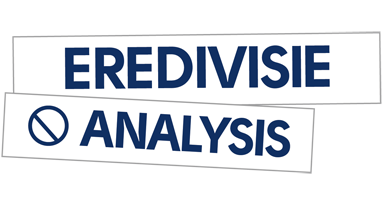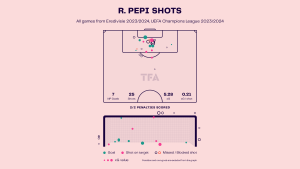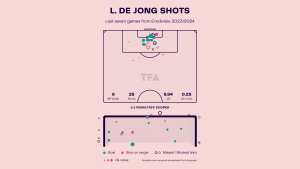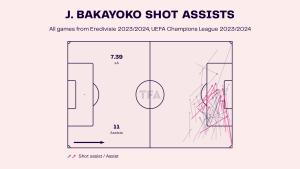Last Saturday the Eredivisie season began for PEC Zwolle and Feyenoord. The result ended up in favour of Feyenoord and they were able to control the match to end up with the victory.
In this tactical analysis, we will see how both teams were positioned and how the earlier goal from Feyenoord change the aspect of ball possession and pressuring for the teams. The statistics of the match shows how PEC Zwolle forced the attack to have a better result but didn’t get it at the end.
Lineups and formations
The manager J. Stegeman positioned PEC Zwolle in a 4-3-3 formation that varied to 4-2-3-1 many times. The starting team were M. Zetterer in the goalkeep; S. van Wermeskerken, S. Kersten, B. van Polen and K. Paal in the defence line. T. Lam, D. Huiberts, J. Drost as midfielders. In the attack zone M. van Duinen, C. Leemans and R. Ghoochannejhad.
Feyenoord’s manager Dick Advocaat didn’t change much of his team since last season where they were close to fight with Ajax for the trophy. Starting position was 4-1-4-1 that turned into a 4-3-3 when attacking. In the goalkeep J. Bijlow. B. Nieuwkoop, L. Geertruida, M. Senesi and R. Haps in the defense line. L. Fer, M. Diemers and O. Kökçü forming the midfield. S. Berghuis, B. Linssen and N. Jørgensen in the offensive zone.
Early goal
The panorama before the match was to see Feyenoord keeping ball possession and PEC Zwolle to explore the counter-attacks. But the earlier goal from Feyenoord’s Berghuis made the tactics in the match a little different.
Earlier in the match, Feeynoord’s attacking movements create a space in the middle of the defence of PEC Zwolle. Berghuis was able to read that space and project himself from the right to receive the ball free to attack.
We can see in the image below that with space to advance and conduct the ball he was able to make the shot from a medium distance and score the first goal of the match.
Pressure on the opponent’s field
With the score in favour, Feyenoord adopted a much lower positioning in the pitch giving the ball to PEC Zwolle posses. It was 56% of ball possession for Zwolle in the match with 86% of pass accuracy. Zwolle had also more attacks per minute: 0.54 against 0.31 of Feyenoord.
That was comfortable for Feyenoord as they lowered their lines but invited pressure when the opponent reached the final third. In the image below we can see Zwolle’s players positioned advanced in the field to go for the tie while Feyenoord’s defence was blocking the penalty area.
In the image above we don’t see Feeynoord’s striker, N. Jørgensen. He didn’t contribute much with the defensive transition and we’ll see more of that later. Zwolle’s T. Lam was often in the midfield with much room to circulate to try to find the key passes.
PEC Zwolle also starts to pressure Feyenoord in their own defence with two or three players engaging in the opponent that had the ball. Especially when they were attacking and lost the ball possession, quicker they try to retrieve it.
In the image below we see the sequence of lost ball possession and three players surrounding and approaching Feyenoord’s midfielder. The engaging movements were clear but not always successful.
Perhaps Zwolle wasn’t prepared to have the ball and had to retrieve when losing it. We see in the match statistics that they won 48% of duels with 0.31 recovery per minute. The second half was particularly more intense and Zwolle ended the match with an impressive 7.7 pressing intensity rate while Feyenoord was 21.1.
But all that pressure didn’t end with goals opportunity. The xG for Zwolle were 0.68 and they shot at goal only five attempts against six of Feyenoord. The chart below shows that Zwolle couldn’t get inside the area to conclude and all shots were taken from medium range.
The Striker (or not)
Much of the lack of great chances of Zwolle was because the striker R. Ghoochannejhad didn’t participate in the match. The fact that the team wasn’t prepared to have the ball, the striker didn’t create his own space or option of receiving the ball.
In the image below we can see one of the moments were Zwolle caught Feyenoord’s defence running back and R. Ghoochannejhad instead of approaches the midfield to create pass option, he chose to be involved by the defenders.
Zwolle’s striker had only 39% of successful actions, 16 passes with only one shot at goal. Defensively he didn’t do much as well. There were 10 losses of the ball and only one recovery and the manager John Stegeman should definitely take a further look at him.
We can’t differ the analysis of R. Ghoochannejhad from N. Jørgensen, Feyenoord’s striker. The former Bundesliga player also didn’t contribute much with the winning.
We saw in the text earlier how he didn’t appear in the frame of the defensive line. That’s because he stood most of the time in the central area surrounding everything but not included. The heatmap below shows where he stood and how weak was his intensity.
Jørgensen had only 36% of successful actions with one shot at goal. He did lose 18 ball possessions and had only one recovery. The fact that Feyenoord opened the score real quick and didn’t want the ball all the time made the team try several long passes from the defence or the goalkeeper.
We can notice in the frame below that the aerial balls from the goalkeeper always were aiming Jørgensen but no one of his teammates was close to him. He struggles alone with the defenders and only won two loose ball duels in the entire match.
Conclusion
The second goal of Feyenoord at the minute 66 intensified the pressure of Zwolle and the lower lines of Feyenoord. In the end, Zwolle kept trying to produce something but was blocked by the good journey of Feeynoord’s defenders. There were 39 interceptions and 22 clearances in the defence.
If Zwolle had more efficiency in the final third to attempt from inside the box then they might have come out with a different result. The manager J. Stegeman will have to work hard on the offensive transition and use the striker R. Ghoochannejhad more.
This analysis showed how Feyenoord took advantage of its earlier goal to propose a different strategy. Giving the ball possession to Zwolle was effective to control the match and secure the winning.

















